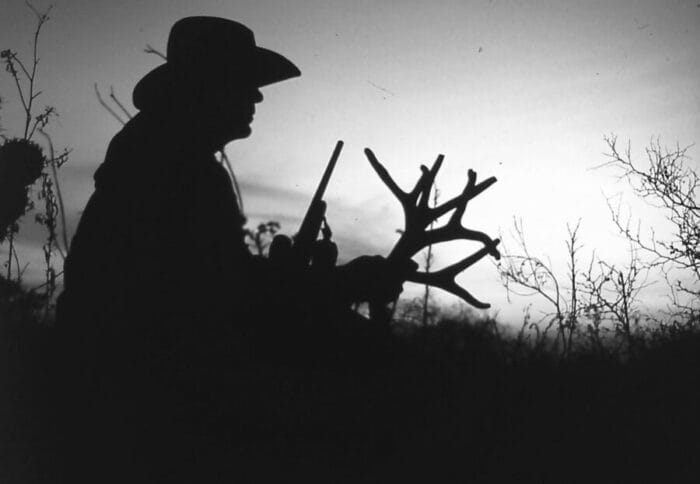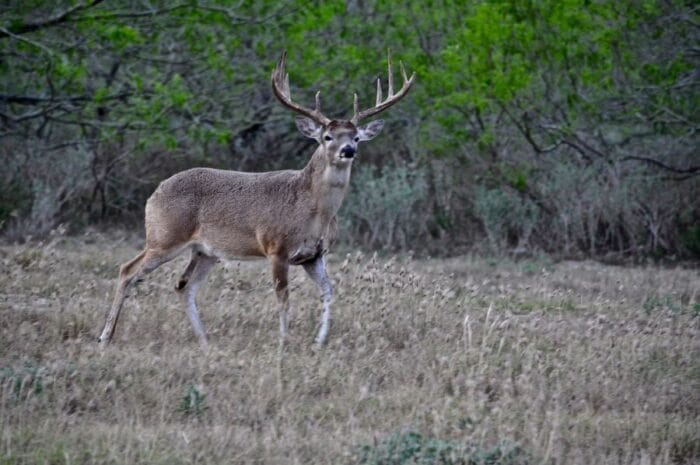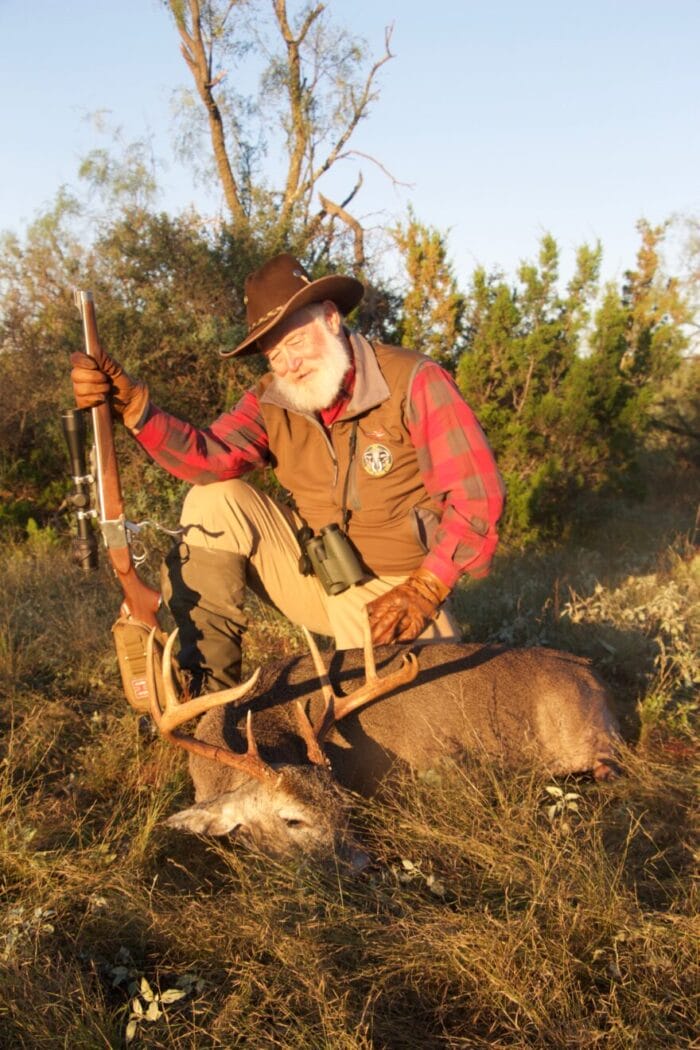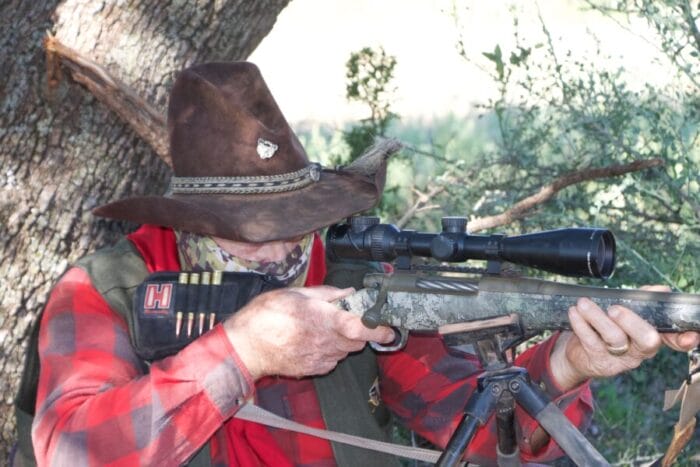Rattling Time: Calling in Big Whitetail
“No Senor! Ningun otro cazador ha sacudido los cuernos est ano. Y tienes razon, ya es hora!” responded Juanito to my query.
It was good to know no other hunter had thus far rattled antlers on the property this year. And I agreed with Jaunito it was time to try to rattle up a buck.
“Has visto algun dolar maduro viejo con atas grandes?” I questioned.
“Si Colorado! Seis con mucho puntos, vigas masivas y tiempo altos. Vi la semana pasada cerca del pequeno Molino d viento d peces.” Said Juanito, pointing to the northwest where I knew the Little Fish windmill was located. If they had been near the mill last week, there was an excellent chance one or more of the six many-pointed, massive, and tall-tined bucks were still in the area and would hopefully respond to my rattling horns.
I thanked the vaquero, grabbed my rattling horns, rifle, and shooting sticks, and headed toward the northwest pasture. The Little Fish windmill pumped water into a shallow pond, which was bordered on the south side by a dense stand of white brush (privet) that covered at least five or six acres. To the north was a slight rise, a ridge covered with black brush. Both brushy areas were ideal places for older mature bucks to bed. I knew the slight rise also had an abundance of granjeno (spiny hackberry), guajacon (one of the few evergreen browses in deep South Texas), and black brush, all excellent food items for whitetail deer. Jutting into both the whitebrush and blackbrush thickets were small openings covered with knee-high prickly pear cactus. I knew I would have several choices where to set up, so I would have shooting lanes to my left and right and directly downwind.
Responding whitetail bucks, especially those with age, should either make their initial approach from downwind or circle to get downwind of the rattling sounds. That is why I wanted shooting lanes to my left and right and directly downwind. I, too, wanted to set up where I could see what approached my rattling. It does no good to rattle in a buck and then be unable to see him.
As a youngster, I taught myself to shoot right and left-handed, whether hunting with a handgun or a rifle. Shooting left-handed has helped me take many animals I would not have been able to shoot had I merely shot from the right side.
I still hunted my way toward the distant windmill, making a downwind approach. In so doing, I slipped within mere yards of several deer, then circled them. If they were going to spook, I wanted those deer to drift downwind, rather than running into the wind, alerting deer upwind of where I was planning on rattling.
As I got to within about a quarter of a mile of the windmill, I slowed down even more to taking three or four short steps, grunting with an “ack,” then taking more steps and again grunting. I had often listened to and watched mature bucks do the same thing as they walk during the rut, essentially letting their presence be known to any buck in the area, almost challenging them. At the same time, they are alerting does, proclaiming themselves to be the sweetest lover in the area! Walking slowly, stopping frequently, and grunting, I have had bucks follow me into the area where I wanted to rattle, particularly during the peak time of the rut.
Thirty minutes later, I was set up with my back against an ancient gnarly mesquite my .270 Win Mossberg Patriot, loaded with Hornady 145-grain ELD-X Precision Hunter, rested on shooting sticks. Before sitting down, I had turned down my Trijicon 2.5-12.5×42 variable to 3x, in case my shot might be close, as I expected.
Set up, rattling horns at my side, the same one I have been using for 30+ years, I sat back and waited ten minutes before starting my rattling sequence. I intended to rattle for about a minute to 90 seconds, wait two minutes, then repeat the rattling, this time upwards of 2-minutes, trying to make as much noise as possible with my tightly gripped rattling horns and by digging my heels into the ground, pushing and if possible also break some limbs with the rattling horns, but also with my feet. If nothing had responded by the time I finished that sequence, I would wait a minute, repeat my last step, and rattling this time up to about 3 minutes, or until my arms really tired! Upon finishing rattling, I generally do a snort-wheeze as I have often seen a “winning” buck do when he chases away the loser.
The snort-wheeze, in those instances, is a challenge for the buck to return or one issued to any other bucks with earing distance. I always plan on staying about 30 minutes after finishing before moving on about a half mile or so to set up a rattling sequence again.
So, very often, older and frequently bigger antlered bucks are slow to respond. Or, they respond immediately but do not come running in; rather than doing so, they will stand downwind for numerous minutes assessing the situation before coming in or turning to walk away. Even when they do, they sometimes return and wait until well after the rattling sequence has been completed.
Sometimes, too, bucks, particularly when it is relatively quiet, come great distances. So, it is essential to give them plenty of time to respond.
Even if I have rattled in one or more bucks in a “sitting,” I still stay approaching 30 minutes after I finish before moving on. In years past, whether I rattled in a buck or not, I was anxious to head to a new area to try it again. That restlessness cost me untold numbers of older and bigger bucks. All too often, as I stood to leave, I spooked a big-bodied, larger-antlered buck, just now coming in…
Rattling Past
I am fortunate; several ranches I hunt in Texas are sizeable, ranging from 1,200 to over 8,000 acres. Thus, I can move around.
When hunting smaller acreages, I tend to stay on the same stand all day or possibly move very short distances if wind directions change. During the “approaching” rut, the peak of the rut, and post-rut hunting those properties, I stay “on the stand” all day long and do a rattling sequence once every 45 minutes to an hour.
Buck fights last mere seconds to hours. I have seen mature bucks fight, never separating their antlers for as long as 8-hours. During that 8 hours, which happened at night under a nightlight on one of the ranches I used to manage, twenty-two different bucks came by to investigate, including five bucks, I saw only that once.
When bucks do respond and start to leave, I generally start grunting at them, using my natural voice. Bucks are like people; even bucks with big antlers and huge bodies can and often do make higher-pitched grunts!
If you have not yet rattled in bucks, do not give up on rattling. I like starting with sizeable antlers. With big antlers, I can make louder rattling sounds and rattle softly. With small rattling antlers, I can only make “soft” rattling sounds.
Rattle where you expect to rattle in a buck, where they exist. Interestingly, the more bucks in an area, the better the chance one or more will want to investigate the rattling sounds you make. There seems to be no rhyme or reason why bucks tend to respond better some days or even during different times of the day.
In deep South Texas, where I spent considerable time hunting in the past, some mornings I thought were ideal for rattling did not produce a single response. But then, usually, those same days after lunch, bucks responded. Some days, I have had great success at first light, other times at the last moments of the day, and all different and odd times of the day. This is one of the reasons I hunt all day long and why I rattle throughout the day.
If you will excuse me, I have a date with a massive antlered buck that likes the sounds I make with my rattling horns!
Should you wish a copy of Larry’s newest book, DEER ADDICTIONS, about hunting deer throughout North America, or CAMPFIRE TALK, which he co-authored with Luke Clayton, you can procure copies by going to catfishradio and clicking on BOOKS in the upper right-hand corner of the website. Both books are available through the SPORTING CLASSICS STORE and now also on AMAZON.




